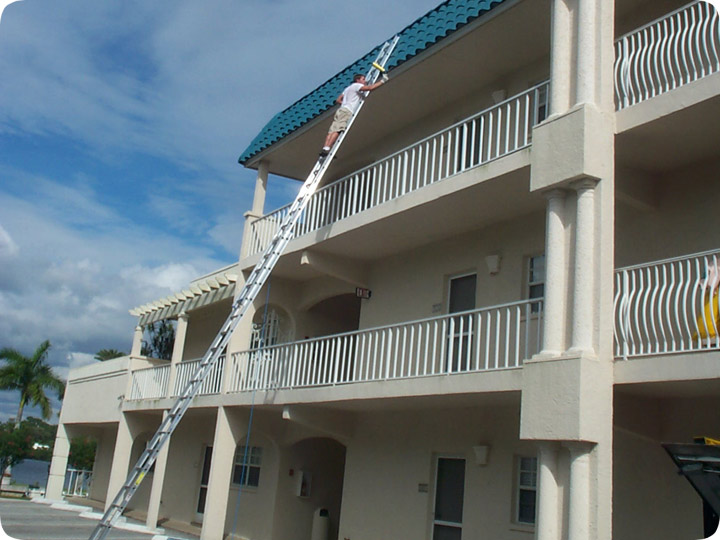-
info@aaanimalcontrol.com
Call us for help in your town
Humane Wildlife Education
Big Bat Removal Project at a Florida Resort

The other companies proposed using bucket lifts. In order to do so, they wanted the resort to remove all of the lamp posts, which were in the way, and also fix all of the landscaping that the lift would damage. This sounds like a big pain, but lifts are, after all, easier than the alternative. I used the alternative - a ladder. In this case, a 40' ladder, fully extended. Ladder use is an integral part of my job, and bat work especially. Bats like high places, and I've got to get up to where they are. A 24' ladder is a cinch to use. I can use a 32' ladder by myself without much trouble. However, a 40' ladder is a whole different ballgame. As the ladder size increases, so does the relative thickness and sturdiness. Thus, the weight increases exponentially, as does the unwieldiness. Gravity has a way of leveraging better over 40'. In short, it's really difficult to move a 40' ladder around. It's impossible for me to do myself, so I had my friend Jon help me. We had to reposition that ladder over 500 times as I worked my way around the building. We had to move the ladder around countless palm trees and shrubs and light posts. Not a single tree or shrub was damaged, and not a single light post had to be removed.
It was an immense, gut-wrenching project. Up and down the huge ladder hundreds of times, working at dangerous heights, installing exclusion netting to remove all of the bats, and sealing thousands of square feet of tile. However, after ten days of brute labor, which for some reason I enjoyed from time to time, the job was complete. No more bats, and with a 3-year guarantee for the resort (though my work will last for the life of the building).
UPDATE - I later found out that the other companies had bid as high as $60,000 for the project, including their intentions to destroy the landscaping and remove the light posts. My final total price, with 100% success and no damage to any of the property: $3300, materials and travel (from Orlando three times) included. Seems I underbid. Live and learn.
Do it yourself: Visit my How To Get Rid of Bats page for tips and advice.
Get professional help: Visit my Nationwide Pro Directory of wildlife removal experts.
For more wildlife stories, click my Wildlife Blog or click my below banner to hire a local trapper.

It is not uncommon for bats to occupy attics and other spaces in homes in Florida. It is also not a rare thing for resorts in Florida to have colonies of bats in the roof of their buildings or other areas.
How Professional Pest Control Services Remove Bats
The design and structure of a resort or home will influence the steps involved in removing bats. Nevertheless, here are the standard steps that a wildlife control service will use to remove bats:
1. Locate the Entry Points
By analyzing potential entry points, a wildlife control service will be able to identify the signs of the presence of bats. They will notice, during proper lighting, signs such as residue around holes from the body of the bats. The presence of bat droppings on the wall is also something that reveals the presence of bats.
2. Secure Possible Entry Points
After identifying the entry points being used by the bats, they will seal up all the other potential points through which they may gain access to the building. The entry points currently being used by the bats will be left open. It will remain like that until after the maternity season and up to the end of the exclusion process.
3. Implement Removal Devices
The professional wildlife removal service will seek to use an exclusion device that is recommended by the Florida Bat Conservancy, Fly By Night Inc., or other institutions that relate to bats in the state of Florida.
4. Allow Bats to Leave
Professional wildlife control services will permit sufficient time to pass so that bats can evacuate the building. Before removing their netting or tubing, a good wildlife control service will observe the premises at the times when bats usually become active to ensure that the bats are all out. It is also an official regulation of Florida that the netting or tubing remains up for no less than four nights. These nights must be warm and without rain or high winds.
5. Completely Seal All the Openings
Once the process of bat exclusion is complete, the professional wildlife control service will remove the netting and tubing during the daytime. They will then move to permanently seal the openings. A sign of a good wildlife control service is that they will not take the netting down without carrying out the work of sealing the openings. If this is not done, the bats will move right back in and the work of exclusion would have been a waste.
The colonization of a resort by bats is not pleasant at all. Luckily, there are professionals that can help to rid resorts of these unwelcomed winged creatures. The work of removing bats from a resort can be a large bat removal project, but when it is done well, the owners will not need to worry about bats anymore.




















